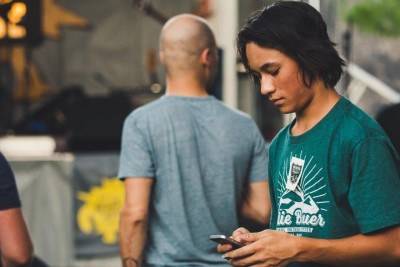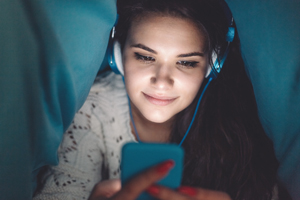Sharing sexual messages and photos online or by phone is called ‘sexting’. Sure, it can be harmless and fun – that’s probably why lots of young people do it.
It’s never been easier to meet others, date and hook up online. Apps like Tinder, Bumble, Grindr and Snapchat, have made flirting online or on a phone much more common.
But sometimes things can go wrong. Sexts might get sent to the wrong person by accident, they may be shared with other people without permission, or posted online to try to hurt or embarrass someone.
It’s important to know that if images are shared without your consent, it’s not your fault. The person who shared it is in the wrong.

Should I send a sext?
While most young people decide to sext because they want to, some feel pressured into sexting.
It’s never OK for someone to pressure you into sending a sext – you can say ‘no’. Finding a way to say no can sometimes be tough, we might feel awkward or not be sure how to go about it. We can all get better at communicating well though, check out our interactive activity for some tips.
If you’re thinking about sexting, it’s worth remembering that relationships can change. Someone you love or trust one day, might be someone you fall out with later.
Photos and videos can be forwarded on purpose or accidentally. This takes the control away from you, and who you’re choosing to share with. Once shared, these images can be in cyberspace forever.
Before sending a sext – you should consider what would happen if the image got into the wrong hands. You also need to consider who you’re sending it to and whether they have consented to receive the image.
What is image-based abuse?
Image-based abuse is when intimate or sexual photos or videos of someone are shared without their permission.
Sometimes the person has given permission for the photo or video to be taken or taken the photo themselves, but then it’s shared without their consent.
At other times the person isn’t even aware that the images were taken. People may also get these kinds of images sent to them against their wishes.
Threatening to share images – even if the images are never actually shared – is also a type of image-based abuse. This is called ‘sextortion’ and for some people is even more distressing than having the images shared.
How common is image-based abuse?
A survey found that one in five Australians have experienced image-based abuse, and females and males are equally likely to experience it.
Young people aged between 16 and 29 are one of the most at-risk groups.
Sexting and the law
Did you know that asking for, taking, having or sharing a sexual photo or video of someone under 18 is actually child pornography in Australia?
The only way to be completely legally safe when sexting is for both people to be over 18 and to consent.
Even if someone only takes a sexually explicit picture of themselves or their partner, it can be illegal. It may also have serious legal consequences, which can end up affecting lots of other parts of a person’s life.
Sometimes images can end up in the wrong hands. Unfortunately, stories of ‘image-based abuse,’ are becoming a lot more common. This can also be a crime. Check out the different laws about image-based abuse in different states.
What can I do if I've experienced image-based abuse?
Once photos or videos have been shared without your consent, it can be very tricky to get them back. But there are some things that you can do.
Remove images and video
If you want an image removed from a website or app, you can contact the administrator and ask them to remove it (on social media, this is usually done by ‘reporting’ the image).
This doesn’t mean that people have not already saved it. If you feel safe, you could contact the person who has shared the photo or video and ask them to remove it and to delete all copies.
Collect evidence
To help police and other services get the photos or videos taken down, take screenshots and copy the web addresses. To find any other websites that might have your image/video, you can do a reverse image search. Having the support of a friend when searching for photos and videos can help. Try not to focus on any comments on the websites − they can be very hurtful.
Report it
You can report image-based abuse to the eSafety Commissioner and they will help get the photo or video taken down. You can also report it to your local police (take your evidence with you).
You can also ask for free, confidential legal support using Youth Law Australia.
Protect your personal details
Sometimes when images are shared, other personal details could be shared at the same time, like phone numbers or online profile details. If you’re receiving any online messages or calls that are nasty or just unwanted, keep records of these contacts and block them.
Talk about how you're feeling
Many young people feel a range of emotions when they’ve experienced image-based abuse. They may feel:
- betrayal
- embarrassment
- shame
- shock
- a sense of loss of power or control
- fear and anger.
Strong emotions can feel uncomfortable and distressing, but they’re also manageable. They will pass with support and time. It might help to share these feelings with trusted people in your life to help you get through.
You may be feeling vulnerable after having your trust betrayed, so surrounding yourself with people who you trust can be comforting.
Care for yourself
Be kind to yourself – it’s not your fault. It can be helpful to give yourself some time off your phone and computer, and care for yourself. Think about what you would say to a good friend if they were going through this and try to say the same things to yourself.
When should I get help?
Image-based abuse can have a serious effect on someone’s mental and physical health. If you have been trying the tips above for some time without improvement, it’s really important to get the support of a professional – like your GP or a mental health professional.
There are mental health professionals at headspace centres and eheadspace (online and phone support) who can help. If you’re at school, TAFE or uni, you may also be able to access a counselling or student wellbeing service.
What can I do if I see images being shared without a person's permission?
If you see images of another person being shared without their permission, try to step in and speak up on their behalf. Try to do this in an assertive but not an aggressive way. You could also let the person in the photo know you’re there for them – they may be feeling very alone.
Remember: Speaking up can be hard because there is often a fear about what might happen if you defend someone else. It’s important to think about your safety before you try to stop the situation. You could reach out directly to the person who’s been affected. If you can’t safely take action yourself don't assume someone else has reported it. Report it to someone you trust and (if you want) you can remain anonymous.
Useful links
For more information or support, visit eheadspace for online and telephone support or find your nearest headspace centre.
Other useful links:
- eSafety Commissioner − this is the Australian eSafety regulatory body. The website has lots of great resources on sexting an image-based abuse. They can help with image-based abuse, cyberbullying, complaints about explicit or illegal content online and other safety issues online.
- Understanding and dealing with bullying – for young people
The headspace Clinical Reference Group oversee and approve clinical resources made available on this website.
Last reviewed 24 January 2023
Get professional support
If you feel you need help there are a range of ways we can support you.

